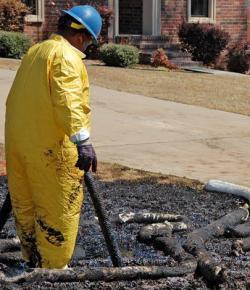An inevitable spill
reports on the spill in Arkansas from a tar sands pipeline--what it shows about the ongoing destruction of the environment in the service of profit.
EXXONMOBIL'S Pegasus pipeline ruptured in Mayflower, Ark., on March 30, marking the second tar sands oil spill in only a few days.
The other spill--a train that derailed in Minnesota--dumped 15,000 gallons of tar sands oil. In Arkansas, ExxonMobil has said it recovered over 12,000 barrels (504,000 gallons) of the toxic mixture of tar sands and water that flows through the pipeline from Canada.
InsideClimate News reported that there are different estimates about the extent of the spill. According to the Pipeline and Hazardous Materials Safety Administration (PHMSA), the pipeline was shut down within 16 minutes of a pressure drop being discovered, but the leak continued for another 12 hours.
The first estimate of how much oil was spilled, put out by the Environmental Protection Agency (EPA), was 2,000 barrels or 84,000 gallons. PHMSA then came out with an estimate of between 3,500 and 5,000 barrels (147,000-210,000 gallons). According to InsideClimate News, the EPA increased its estimate to 4,000-7,000 barrels (168,000-294,000 gallons). Exxon (whose own figure of more than 12,000 barrels recovered includes both oil and water) hasn't endorsed either of the higher estimates--presumably because the higher the amount spilled, the greater the fine.

But whether it was 2,000 or more than 7,000 barrels, the pipeline spill far surpassed the 250-barrel cutoff categorizing it as a "major spill." Twenty-two Mayflower homes, now with oil-filled yards, have been evacuated.
Up to this point, no oil has entered any waterways, which is a relief considering the kind of oil that spilled: a type of diluted bitumen (also known as "dilbit"). Dilbit is heavier than most conventional crude oil, causing it to submerge in water and making cleanups extremely difficult. In Michigan in 2010, more than 1 million gallons of dilbit gushed from a pipeline into the Kalamazoo River. After close to three years, the cleanup struggle continues.
On April 7, however, activists with Tar Sands Blockade released video showing runoff from the Arkansas spill being diverted from a residential neighborhood into a wetland area. Exxon has been preventing media from filming the spill--the activists reportedly had to sneak into the site to record the video.
Speaking with Amy Goodman on Democracy Now!, Bill McKibbon, the climate activist and founder of 350.org, related the Pegasus pipeline to the Keystone XL, which activists have been protesting to pressure the federal government not to approve its construction. The Pegasus pipeline carries about 80,000 barrels a day, McKibbon said, whereas the Keystone XL would carry 800,000 barrels a day.
Multiplying the Pegasus spill by 10 gives us an idea of what we could face in the near future if Obama okays the Keystone pipeline, as is expected.
THE BROADER context of the protests over the Keystone is the certainty that a functioning pipeline would contribute to irreversible climate change. We are already well above 350 parts per million (ppm) of carbon dioxide in the atmosphere, a number that has been identified as the climate "tipping point"--leading to a warming of 2 degrees Celsius--after which the environment will suffer catastrophic damage.
In an article titled "Game Over for the Climate," NASA climate scientist James Hansen explained how exploiting Canada's tar sands would put human civilization "at risk." Drilling Canada's tar sands alone would increase carbon dioxide in the atmosphere by 120 ppm. In Hansen's words:
If we turn to these dirtiest of fuels, instead of finding ways to phase out our addiction to fossil fuels, there is no hope of keeping carbon concentrations below 500 ppm--a level that would, as earth's history shows, leave our children a climate system that is out of their control.
According to Chris Williams, author of Ecology and Socialism, by utilizing the current technology for different types of renewable energy, like wind, solar, geothermal and tidal, our planet could be carbon neutral by 2030.
Technology isn't the barrier to solving the ecological crisis, nor are the individual actions of the vast majority of people. At the root of this injustice is capitalism, an economic system that worships profits, even when they come from unsustainable energy practices. In the long run, no one except energy companies will benefit from burning fossil fuels or from tar sands drilling.
Why, then, is Barack Obama even considering approving the Keystone XL pipeline? Because his administration serves the interests of the 1 Percent--including those who prioritize short-term profit over the environment.
The administration claims the Keystone pipeline will create jobs and stimulate the economy. It may, for some--but only until the pipeline is built. After completion, it will take only a few workers to maintain the pipeline. Oil executives will rack up billions while the rest of the world suffers the environmental consequences, including oil spills, pollution and climate change.
The government could create lasting jobs by putting people to work rebuilding the nation's infrastructure and transitioning to renewable energy instead of fossil fuels. Exploiting the environment, and taking Earth's resources, however, is more profitable.
ExxonMobil may be fined millions of dollars for the Arkansas spill, but this will hardly make a dent in its $44.8 billion in profits during 2012 alone. Once the spill is cleaned up (or not) and the fines paid, ExxonMobil will continue making billions by exploiting the environment.
Only through a social movement from below can we begin to pressure the government to prevent future spills, reverse climate change and radically change the system that endangers the planet.


